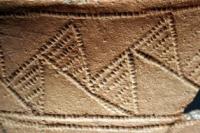You are here
Sufi Dynasty mausoleum.

Heritage tourism in Turkmenistan.
“On the sample of Kunya-Urgench monuments one can see all variety of methods and décor of Islamic architecture of Central Asia. There are constructions from adobe and burned bricks, plain unicameral dome constructions up-going to ancient chartak and buildings with complicated compositions, sometimes with а long history of development, repair and reconstruction”
Kunya-Urgnech in history of the Great Silk way.
This mausoleum in the abandoned medieval city of Kunya-Urgench (or Gurganj) is notable for its unconformity with the accepted regional types and periods of styles, in its innovations in plan, structure and architectural elements.
Erected in 1370 as the family shrine of the short-lived Sufi Dynasty, it is believed to entomb Husayn Muhammad Giyath ad-Din Sufi (1332 - 1370). Popular traditions ascribing the structure to Turabeg Khanum, wife of Batu'id Golden Horde's Governor Qutlugh Timur, are reinforced by her patronage of the neighboring khanqah of Shaikh Najm al-Din Kubra, the founder of the Sufi Kubrawi order.
The lack of any inscriptions and the tomb's proto-Timurid architectural features (such as a double dome, mosaic faience and magnified pishtaq) add further controversy. Its polygonal rotunda is terraced in the manner of Shiite tomb towers, bringing the tomb stylistically closer to fourteenth century Iran rather than the period architecture at Khorezm.
The plan consists of three distinct spaces in a highly geometric and east-west oriented layout. The mausoleum's twenty-five meter high, east-facing pishtaq encloses a vestibule, with ancillary chambers on each side.
Of these, the northern chamber accommodates a staircase ascending to the roof. The vestibule leads to an octagonal burial chamber that appears dodecagonal on the exterior. This space is covered with a dome, which is approximately nine meters in diameter and has four windows.
The ingenuous use of exterior buttresses has created symmetrical exterior elevations emphasized with multi-faceted iwans. Past the burial chamber lies a rectangular area containing a staircase descending into the burial crypt.
A domed structure of a later, unidentified date stands beyond the mausoleum's missing western wall. The dome's high drum rises above the shrine's flat roof, and is framed by twenty-four terracotta panels adorned with staggered rows of stars.
Only a few segments of the turquoise, ribbed outer dome remain. The lack of a dedicatory plaque and decorative revetments on the yellow brick portals lends credence to the belief that the exterior decoration was never completed.
The dome's interiors are profusely adorned with mosaic faience with interlocking star patterns using a wide palette of colors. Interstices in this design are filled with geometrical forms, vegetal patterns and inscriptions.
The drum is decorated with similar patterns on arched panels of blue glazed terracotta patterns. Overshadowed by Khiva Ichan-Kala World Heritage site, this mausoleum located in the remote Kara-Kum desert has not attracted the tourist attention it deserves. Intense preservation efforts in the past decades have stemmed danger of structural collapse.
Authority:
Borodina, Iraida. 1987. Central Asia. Gems of 9th-19th century Architecture. Moscow: Planeta Publishers, 33. Golombek, Lisa and Donald Wilber. 1988. The Timurid Architecture of Iran and Turan. Princeton: Princeton University Press, 231-232. Hillenbrand, Robert. 1994. Islamic Architecture. Edinburgh: Edinburgh University Press, 297, 300. Michell, George. 1978. Architecture of the Islamic World. London: Thames & Hudson Ltd, 262.







